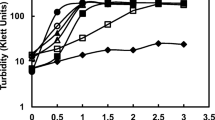Abstract
The toxicity of chlorophenoxy herbicides to a bacterium, strongly related to the well-known species Delftia (formerly Comamonas) acidovorans that are able to detoxify these xenobiotics, was investigated. The oxidation of n-hexanol via alcohol dehydrogenases, coupled with the generation of ATP by electron transport phosphorylation (ETP), was used as an indicator for energy-toxic effects on the growth of Comamonas testosteroni ATCC 17454.
Uncoupling—reductions in ATP synthesis accompanied by increased respiration—was found to be induced by 1 mM of the classic uncoupler 2,4-dinitrophenol (2,4-DNP) at pH 7.0 and 8.0. At pH 5.4 and 6.0, the ATP synthesis and respiration were strongly inhibited by both 2,4-DNP and the chlorophenoxy herbicides tested. In contrast, 5 mM of 2,4-dichlorophenoxyacetic acid (2,4-D) and of 2-(2,4-dichlorophenoxy)-propanoic acid (2,4-DCPP) were required for detectable uncoupling effects—reduction of the P/O ratios by about 30%—at pH 7.0. These chemicals may have less uncoupling power because the concentration of their protonated (undissociated) forms (pKa values 2.7 and 3.0) is an order of magnitude lower than that of 2,4-DNP (pKa = 4.0) at this pH value.
Strong uncoupling accompanied by increased respiration, like that induced by 1 mM 2,4-DNP, was also caused by 5 mM 4-(2,4-dichlorophenoxy)-butyric acid (2,4-DCPB), which correlates with its high pKa value of 4.6.
The order of toxicity of the chlorophenoxy herbicides (2,4-D < 2,4-DCPP < 2,4-DCPB) to the ETP, which correlates well with the lipophilicity of their undissociated forms (log P 2.7 < 3.4 < 3.5, respectively), was confirmed by measuring their capacity to inhibit the growth of Comamonas testosteroni ATCC 17454.
The results show that energization via alcohol dehydrogenases can be used as an indicator for investigating energy-toxic effects of organics on the ETP and growth of chlorophenoxy herbicide-detoxifying bacteria.
Similar content being viewed by others

Author information
Authors and Affiliations
Rights and permissions
About this article
Cite this article
Loffhagen, ., Härtig, . & Babel, . Energization of Comamonas testosteroni ATCC 17454 for Indicating Toxic Effects of Chlorophenoxy Herbicides. Arch Environ Contam Toxicol 45, 317–323 (2003). https://doi.org/10.1007/s00244-003-2142-6
Issue Date:
DOI: https://doi.org/10.1007/s00244-003-2142-6



